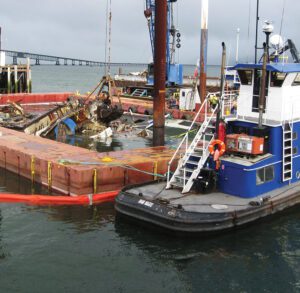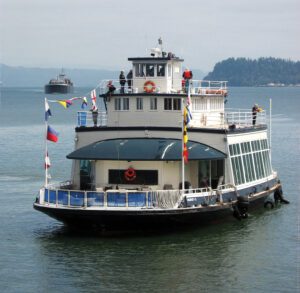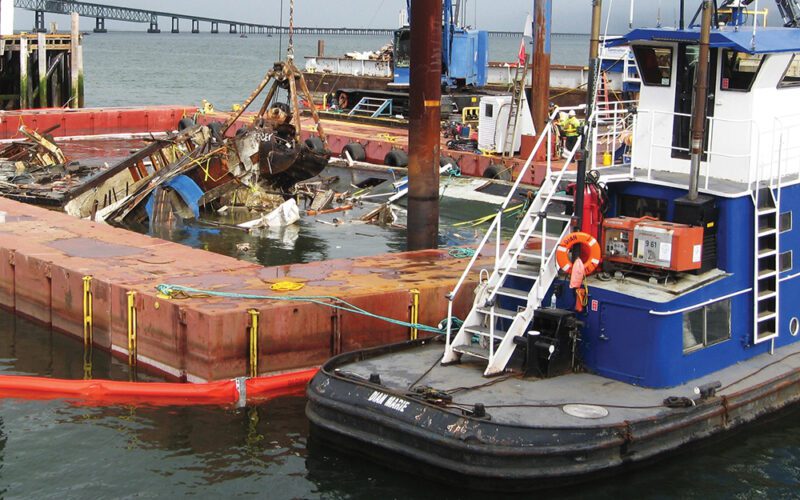
Abandoned and derelict vessels (ADVs) are such a growing problem on the Northwest coast that the Pacific States/British Columbia Oil Spill Task Force organized an ADV workgroup in 2018. The latest move came Oregon’s Department of State Lands (DSL) publishing a memorandum on Aug. 9, 2022 that outlined a three-year ADV removal plan with a budget of $40 million.
The DSL estimated there were 19 commercial ADVs and 175 smaller recreational derelict boats statewide. The largest and most significant were the 95-year old 125-foot U.S. Coast Guard cutter Alert and the 100-foot World War II U.S. Navy tug Sakarissa sunk in the shallows on the south channel of the Columbia River close to the I-5 bridge.
However, in the first week of August, the DSL was faced with a more immediate problem: the 110-foot by 36-foot former Astoria car ferry Tourist No. 2 that had just sunk on the Astoria waterfront.
After an initial effort to refloat the wooden vessel using a crane barge and a dive team was called off because of the hull’s very poor condition, it was judged to be an immediate risk because of the adjacent fuel dock and the vital Columbia River shipping channel, with the continued impact of the tides and river current.
The recurring problem with removing most ADVs is the cost, but also the tangle of agencies that may be involved, including in this case the U.S. Coast Guard, Oregon State Marine Board and Department of Environmental Quality, city and county councils etc.
“Not taking action to remove this hazard from the water is not an option,” DSL director Vicki Walker stated when the state took the lead role.
Global Diving and Salvage was awarded the contract to remove the fuel and oil and clean the entire wreck site with the predicted cost in excess of $1 million.
A professional salvage crew from sub-contractor Advanced American Construction arrived from Portland with a crane barge and a deck barge carrying a sufficient length of oil boom, a small tug and a skiff. Bruce Jones, the Mayor of Astoria and former commander of US Coast Guard Sector Columbia began putting out updates online.
On Aug. 6 he reported: “Yesterday divers pumped 125 gallons of diesel from the fuel tank, emptying it, and removed 5 cubic yards of fuel-soaked absorbent material, three-by-five gallon containers of motor oil, propane tanks, paint, other assorted hazardous waste and fuel soaked life jackets and other materials.”
On Aug. 10 he noted that Advanced American and the DSL had decided to build a cofferdam around the wreck. A large number of pontoons were loaded onto another barge at the company’s dock under the St. Johns bridge in Northwest Portland and connected together to surround the wreck.
This gave the salvors a floating walkway around the waterlogged Tourist No. 2 when the crane barge began the demolition with its heavy claw. The once-proud ferry was quickly reduced to a pile of crushed lumber on the cargo barge’s deck.
“This was a sad ending to a historic vessel, but unfortunately, her fate was sealed many years ago when the extensive, expensive hull maintenance that old wooden boats require was not performed regularly,” Jones explained in his final report.

Coincidentally, the boat ended its long life just eight blocks away from the ferry service’s original berth where it had plied its trade across the Columbia from 1924 to 1966, with four years in military service during World War II.
1966 was the year the toll bridge across the Columbia River was opened, leaving the three-boat ferry fleet unemployed. The Tourist No. 2 moved on to Puget Sound where it worked for the next half century, first as a ferry then as a party boat.
After a fire in the electric system in 2010, the owners retired the boat and sold at a bargain price to Christian Lint, an experienced seaman and old boat aficionado. He repaired the damage and rented the boat out for special events, reportedly resisting offers to turn it into “a floating casino, strip club or cannabis bar.”
By 2016, he decided the old boat would find a better situation in its home waters on the lower Columbia River where a celebration was planned for the 50th anniversary of the bridge that had put it out of work. The ferry quickly attracted a fan base and a group formed to developed plans for a non-profit to turn it into a floating museum.
As the months slipped by, the estimated amounts of time and money required to restore the aged hull kept increasing and eventually wore the committee out, leaving Lint and the boat back at square one.
Unable or unwilling to pay the moorage fees, at the age of 70 he scanned the waterfront for a spot where he could moor free of charge, and found an empty submerged lot on the downtown waterfront where a dozen steel pilings had been driven for a condo project that had also ran out of funds.
That was where his luck ran out when the automatic bilge pump he was powering with a small wind turbine and solar panel failed to handle a leak below the waterline.
That unfortunate event should have marked the end of this coastal saga, but the story took an unexpected and truly tragic turn in Portland on Aug. 30 as the salvage crew were winding up the operation.
Lint had been living at a houseboat moorage in Portland and avoiding the spotlight, and was seemingly more concerned about an entirely unrelated issue—the theft of vehicles and car parts from the moorage car park. After his pickup had been stolen twice, he installed a camera and alarm in the vehicle.
On the night of Aug. 31, he saw the thieves prowling around the parking lot on camera and raced up the dock with a handgun to confront them. In the altercation that ensued, his gun was taken, he was struck multiple times and pushed or thrown into the busy street, where he was hit by a semi-truck and killed.
No arrests had been made and this case was added to a long list of serious crimes involving the criminal element among the thousands of people living on the streets, parks and rivers around Portland.

